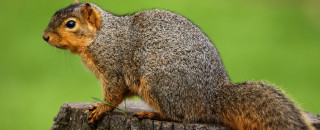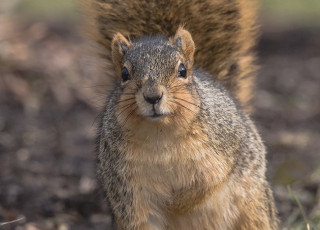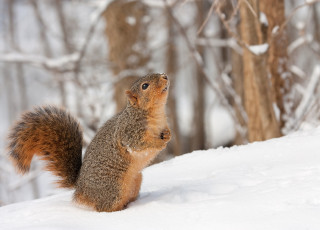Salt Lake City's Fox Squirrels: Answers to Your Top Questions
Squirrel Fest is back! Whether you're a casual observer of backyard wildlife, or you're a seasoned zoologist, we want your help tracking sightings of fox squirrels in Utah. Submit your sightings during Squirrel Fest, happening December 7–15. Learn more.
By Mark Johnston
You might have many questions about squirrels in Salt Lake City and you are not alone. In the past decade, squirrel populations have boomed along the Wasatch Front thanks in part to the introduction of a new species, the eastern fox squirrel (Sciurus niger). Running along powerlines, raiding bird feeders, taunting pets, braving city streets, and bounding between tree limbs, these charismatic rodents are entertaining to some of us but can be an outright nuisance to others. They are large, charismatic, quite loud, and hard to ignore. And with their growing footprint in Utah, the Museum is receiving more squirrel questions than ever while it actively tracks the squirrels’ impact on the environment with help from citizen science observers.
To best answer all your questions, we have consolidated information from various resources on our site, along with expert input from our resident vertebrate zoologists, to provide you with this quick-reference guide on Utah’s fox squirrels.
What squirrels can I see in Salt Lake City?
Utah’s native squirrels are those that have lived in this region for as long as humans have been keeping record. They include the American red squirrel (Tamiasciurus hudsonicus) and rock squirrels (Otospermophilus variegatus).
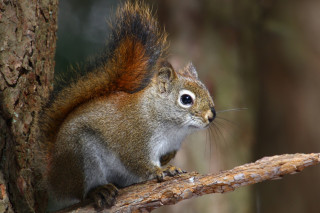
American red squirrels are small, about 12–16 inches long with dark, reddish-brown backs and a pale, creamy underside. They sport a bushy, reddish tail and are commonly found in conifer trees in parks. They are not native to the valley floor and only moved down from the mountain conifer forests after the urban forests developed.
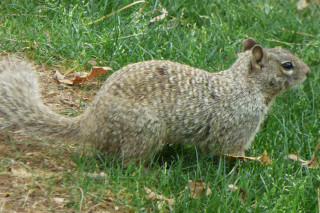
Rock squirrels are larger than red squirrels and have gray backs featuring yellow and brown highlights. Their underside is also pale like the American red squirrel, but their tail is only slightly bushy. They spend most of their time on the ground and run rather than bound, like other squirrels.
Fox squirrels are an introduced species that are large compared to the native squirrels, ranging from 18–28 inches long including the tail. They have gray and orange backs with pale yellow or bright orange undersides. Their tails are very bushy and bright orange, much like a fox! You’ll spot them living in trees and traveling along powerlines or fences, and they now can be found at least as far north as Ogden and south to Utah County.
How did fox squirrels get here?
Fox squirrels were first reported in Utah in 2011 along the Jordan River in Salt Lake City. Their arrival is a bit of a mystery, but they were either purposefully or accidentally introduced by humans as pets or in cargo. Since their arrival, their population has spread rapidly throughout the urban environment, and NHMU’s scientists have been tracking their proliferation through a popular citizen science initiative.
Do fox squirrels push out the other native species?
Citizen squirrel observers have reported many sightings of fox squirrels with native species. While far larger than the American red squirrel, there is no evidence yet that fox squirrels force them out of their habitats. Combative interactions between them have been reported between these two species, but these reports have also noted that smaller American red squirrels appear more aggressive when defending food from a larger fox squirrel. On the other hand, fox squirrels can impact birds as the squirrels build their dreys (nests) in trees and even feed on eggs or hatchlings.
Fox squirrels may actually be beneficial to some native species, as many squirrel observers have reported seeing fox squirrels hunted or captured by native predators, like hawks and coyotes.
Are fox squirrels considered pests?
Some residents see fox squirrels as entertaining wildlife in our neighborhoods, while others consider them troublesome pests, which is understandable. The squirrels are opportunists and will seek food and shelter wherever they can find it. This includes building nests inside attics, which might cause damage, or pillaging gardens, fruit trees, and bird feeders while seeking food throughout the year.
Can they be harmful? Do they carry diseases?
While there are no reports of fox squirrels posing immediate threats to humans or pets, as with many mammals there is always the risk of animal-borne diseases like the hantaviruses spread by other rodents. For now, the consensus is that it is unlikely they carry any disease that might be transferred to people.
As with any wild animal, there is always the risk a fox squirrel might scratch or bite when defending itself. However, its most common defense is avoidance by scampering up a tree, building, or powerline.
How do I keep squirrels out of my house or yard? How do I get rid of squirrels?
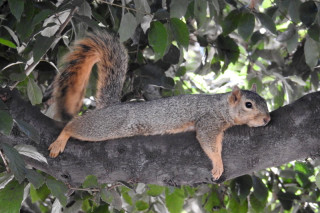
If you are experiencing troublesome interactions with fox squirrels in your home or garden, then it’s understandable that you want them removed. First note that it’s likely that something is enticing the animals, like easy access to an attic, an excess of bird seed, or tasty, unguarded vegetables. The best way to reduce contact with the squirrels would be to limit access to any of these benefits they might be seeking around your home.
But if they become severe pests causing lots of damage, it’s understandable that you might consider other pest removal options, including traps or poison. However, most importantly, do not relocate squirrels after capturing them in your home or garden. There is evidence to suggest that the fox squirrel’s range has grown far wider than it otherwise would have due to humans relocating squirrels after trapping them.
While there is no evidence that fox squirrels are having major impacts on native fauna in the city, releasing them in nearby wilderness areas may allow them to establish and push out other native species. Conversely, fox squirrels really thrive in the urban environment because of the abundance of resources, but most wilderness areas surrounding the Salt Lake Valley host habitats in which they cannot survive, such as deserts and pine forests.
However you choose to proceed, know that we cannot eliminate them from our neighborhoods – they are part of the ecosystem here now Removal will only create a vacuum that will fill again as they continue to breed, and populations increase exponentially.
What do fox squirrels eat? What can I feed squirrels?
Some people are surprised to learn that squirrels are omnivores that feed on a wide range of foods, from their typical diet of nuts, fruit, and seeds, to carnivorous consumption of bird eggs and nestlings.
Squirrels are rodents who share a common characteristic that their teeth continue to grow throughout their lives. Chewing on hard objects is the best means for rodents to control the length of their teeth, which is critical for their survival. So hard nuts—like walnuts, chestnuts, and acorns—are an idea food source for sustenance and dental care!
Are there more fox squirrels than there used to be? Will populations continue to increase?
Yes, and yes. Since fox squirrels were first observed in Utah in 2011, there has been a boom in their population making them common in many neighborhoods along the Wasatch Front. Females have two litters a year in March and July, each averaging three offspring. So, while they face many hazards—from cars to coyotes—they are likely reproducing faster than they’re dying due to an abundance of resources in our parks and yards. Have you seen an increase of squirrels in your neighborhood? If so, reach out and tell us during Squirrel Fest.
Help NHMU track fox squirrels during Squirrel Fest
If you have read this much then consider yourself an ideal candidate to join NHMU during Squirrel Fest, an annual data collection extravaganza running from December 2–10 across Utah. Learn more.
